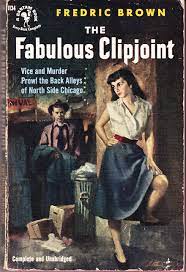Old Bestseller Review: The Fabulous Clipjoint, by Fredric Brown
by Rich Horton
Here's another review of a postwar crime novel, in this case a very pure example of "noir" fiction (though am I supposed to use noir in talking about books rather than film?) The Fabulous Clipjoint was first published as "Dead Man's Indemnity" in Mystery Book Magazine in 1946, the same year as my previous crime novel, Crows Don't Count, by "A. A. Fair". The book version, expanded and with an infinitely superior (and less spoilery) title, came out from E. P. Dutton in 1947. It won the Edgar Award for Best First Mystery Novel in 1948. My copy is the second printing of the Bantam paperback, from 1953. (The first printing was in 1948.) The inside copy credits the cover to Ed Grant, but I think that's for the first paperback printing (reproduced below.) The signature on this one looks different -- I'm not sure who did the cover.Fredric Brown (1906-1972) has long been well known to me as a Science Fiction writer -- his story "Arena" (possibly the source material for the Star Trek episode of the same name) appeared in the Science Fiction Hall of Fame, and he wrote many other fine short stories, including a great many short-shorts; and also several fine SF novels (The Lights in the Sky are Stars, What Mad Universe?, Martians Go Home.) But he wrote in many genres, and arguably he was at his best writing crime fiction -- or, so I have been told. I decided I'd read one of his mystery novels, and started with The Fabulous Clipjoint, which was, as noted, his first. (Indeed, the two detective characters, Ed Hunter and his uncle Ambrose, appeared in several further novels.)
Ed Hunter is 18 years old, having just started working at the printer's where his father works in Chicago. His mother is long dead, and his father has remarried, and he has a stepsister, Gardie, who is 14 but trying to act 18 or more. He knows his father isn't happy, his stepmother always on his father's case. And this morning his father hasn't come home, after his usual routine of having a beer or two or three at several bars. And then the police come -- his father has been found murdered in an alley.
Ed's first move is to visit his uncle Ambrose, a carnie, up in Wisconsin. And, perhaps to Ed's surprise, Ambrose comes with him back to Chicago; and before long he's convinced Ed they need to try to find his father's killer. After all, the police are sympathetic but have no real leads -- people are killed for their wallets every night in Chicago, it seems. Ambrose has hidden depths -- it turns out he was once a private investigator. And he has stories about Ed's father, Wally, and their youthful escapades in places like Mexico, including romantic stuff like a duel and an affair with a married woman.
The novel, then, follows the course of their amateurish investigation. Along the way we learn more about Wally's desperation, his unhappy second marriage, the reason he moved from Gary, Indiana to Chicago. There are hints of a past involvement with gangsters. Ambrose teaches Ed how to act as they interrogate Wally's last contacts, such as a shady bartender, and his best friend at the printer's, etc. Meanwhile Gardie comes on to Ed; the police begin to show interest in Ed's stepmother as a suspect, and a gangster and his hired heavies show up. And, tracking one lead, a mysterious phone number, Ed comes into contact with a beautiful older woman ...
This is all pure noir -- if noir is the right word for a novel, not a film. The depiction of Chicago's meaner streets is excellent. The characters of Ed and Ambrose are well-portrayed, if the women -- the grasping stepmother, the sluttish stepsister, the "heart of silver (not quite gold)" gun moll -- are perhaps a tad clichéd. The mystery is appropriately twisty, though it turns to an extent on a slightly improbable psychological quirk. But on the whole it convinces. And the final chapter, where at last we learn the meaning of the title, is simply beautiful. This is a wonderful novel -- post war noirish crime fiction at its peak.
Here's the cover of the first paperback edition, by Ed Grant:



This is one I've wanted to read for a while. I've read two of Brown's other noir mysteries - His Name Was Death, which I thought was terrific, and The Screaming Mimi, which was only so-so. (I have Brown's The Far Cry on a shelf around here somewhere and may get to it before new year's.) Have you read any of the Harlem police procedurals by Chester Himes? They're extraordinary.
ReplyDelete